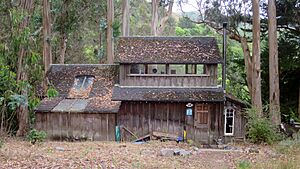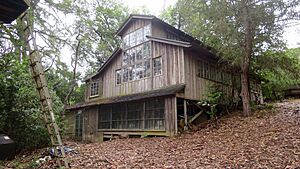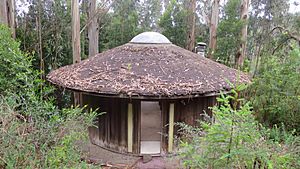Druid Heights facts for kids
Quick facts for kids
Druid Heights
|
|
|---|---|
|
Counterculture Enclave
|
|
 |
|
| Founded by | Elsa Gidlow, |
Druid Heights was a special community in Marin County, California, USA. It was a place where people with new ideas, often called "counterculture," lived and worked together. This unique spot was bought in 1954 by a poet named Elsa Gidlow. She later shared the land with a carpenter, Roger Somers, and his wife, Mary.
In 1956, Elsa named her part of the land Druid Heights. Today, the whole area is known by this name. The people living there shared common values and helped each other. This was important because the area was quite remote. There was no city water, no sewers, and no city help for the three-mile dirt road. The neighbors had to work together to keep these important services going. This remote and special place attracted many creative people. It became a hub for different counterculture movements. Many famous writers and artists from the San Francisco Renaissance also visited or lived there.
Contents
A Unique Community's Story
Elsa Gidlow, who started Druid Heights, jokingly called it an "unintentional" community. It was located on the side of Mount Tamalpais in Marin County, California. This spot was about a mile from the Pacific Ocean. The land was once a chicken ranch. Elsa Gidlow bought the five acres. In 1954, she legally split the land. She shared it with carpenter Roger Somers and his wife Mary.
In 1956, Elsa named her two acres Druid Heights. She chose the name to honor two female writers. One was Ella Young, a teacher of Irish stories. The other was Emily Brontë, who wrote Wuthering Heights.
A Meeting Place for New Ideas
The people of Druid Heights allowed their land to be a meeting place. It hosted three important movements in the United States. These included the Beat Generation of the 1950s. It also welcomed the hippie movement of the 1960s. Finally, it was a place for the women's movement of the 1970s.
Thanks to Elsa Gidlow, it also became a safe place for many famous people. These included figures from the San Francisco Renaissance. Her friends like Kenneth Rexroth visited. Gary Snyder, a Pulitzer Prize winner, also lived there for a time.
The community was reached by a dirt road. This road connected to Muir Woods Road. Roger Somers was a skilled craftsman. He was inspired by Japanese architecture and American architect Frank Lloyd Wright. He built or updated many of the buildings. He got help from Ed Stiles, a furniture designer. Elsa Gidlow loved gardening. She grew vegetables using organic agriculture. She shared her extra vegetables with others.
The Society For Comparative Philosophy
Elsa Gidlow and Alan Watts started a non-profit group in 1962. It was called The Society For Comparative Philosophy. They wanted to study how humans relate to nature and the universe. They bought a converted ferry boat called Vallejo. This boat was meant to be the group's main office. It would also host talks and events. This way, Druid Heights could remain a private place. Only insiders and invited guests could enjoy it.
The Society faced difficulties after Alan Watts died in 1973. But it was later brought back to life. It continued until Elsa Gidlow's death in 1987.
Elsa Gidlow had hoped to make Druid Heights a retreat for artists. People would pay to stay there. However, the National Park Service bought the land in 1977. They used a process called eminent domain. This means the government can buy private land for public use. After this, Druid Heights could no longer host temporary guests. It could only have long-term residents. Druid Heights is located above Muir Woods National Monument. It is now on the National Register of Historic Places. This means it is recognized as an important historical site.
Special Buildings and Structures
"With [Gidlow's] skill as a gardener and [Somers'] as an architect they transformed this area into a paradise, a Garden of Eden...All this they accomplished with imagination and muscle...It has what people who are only rich find so frustrating, because you cannot buy it with money."
Today, there are about 16 historic buildings and structures at Druid Heights. Elsa Gidlow's own house is very important. But it is in danger because it needs repairs.
Other remaining structures include:
- Cloud Hidden: This is a large rock. Alan Watts gave it this name.
- The Library: This building was made in 1972. It was built from a redwood water tank. It was first used to hold Alan Watts' books and papers.
- Mandala House: This cabin is shaped like a lotus flower. Ed Stiles built it for Elsa Gidlow's sister. Alan and Jano Watts later rented it from 1970 until Alan's death in 1973.
- The Goddess Meditation Hut: This small building has beautiful stained glass windows.
- Love Garden: This garden was filled with plants. Elsa Gidlow brought them from her other house. She took care of the garden with many friends.
- Water Tank: This tank was installed to hold water. The water was pumped from a creek. It was for all 12 residents to share.
- The Ranch or Twin Peaks House: This was a small house built in the 1920s. Roger Somers greatly changed it. He added parts of Japanese, Polynesian, and Modern Architecture.
- The Old Chicken Barn: This barn was built for chickens in 1943. Roger Somers and a sculptor named Jerry Walter turned it into an art studio and home. Ed Stiles later added more to this building. He even put in a special redwood tub and shower in the bathroom.
People Who Lived There
Many interesting people lived at Druid Heights over the years. Some of them include:
- Robert Erickson
- Elsa Gidlow
- Echo Heron
- Isabel Quallo
- Gary Snyder
- Roger Somers
- Ed Stiles
- Margo St. James
- Alan Watts
- David Wills





